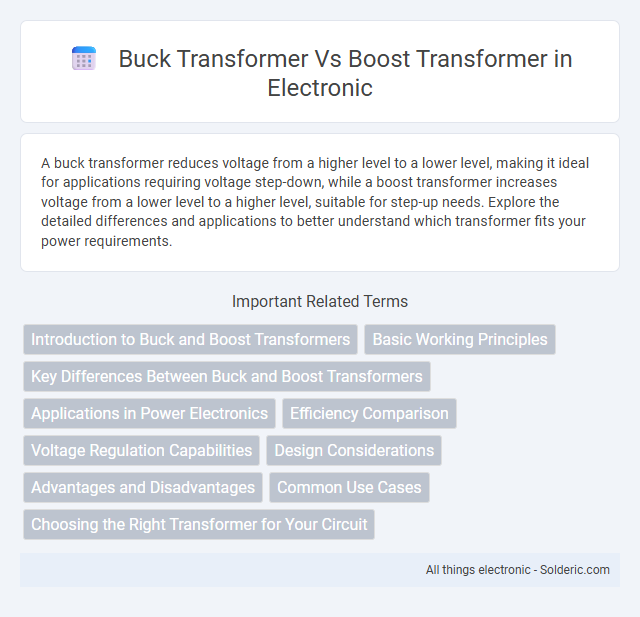A buck transformer reduces voltage from a higher level to a lower level, making it ideal for applications requiring voltage step-down, while a boost transformer increases voltage from a lower level to a higher level, suitable for step-up needs. Explore the detailed differences and applications to better understand which transformer fits your power requirements.
Comparison Table
| Feature | Buck Transformer | Boost Transformer |
|---|---|---|
| Primary Function | Step-down voltage | Step-up voltage |
| Output Voltage | Lower than input voltage | Higher than input voltage |
| Use Case | Power supplies, voltage regulation | Power amplification, voltage increase |
| Efficiency | High efficiency at lower voltage | Variable efficiency, may drop at high boost |
| Complexity | Simple design | More complex design |
| Typical Applications | Battery chargers, LED drivers | Power inverters, renewable energy systems |
Introduction to Buck and Boost Transformers
Buck transformers reduce voltage levels by stepping down input voltage to a lower output voltage, making them essential for applications requiring voltage regulation and energy efficiency. Boost transformers increase voltage by stepping up the input voltage to a higher output voltage, which is critical in systems needing elevated voltage levels for device operation or transmission. Your choice between buck and boost transformers depends on whether your system requires voltage reduction or elevation for optimal performance.
Basic Working Principles
A buck transformer operates by stepping down voltage from a higher level to a lower level through electromagnetic induction, effectively reducing the output voltage while maintaining power balance. In contrast, a boost transformer steps up voltage from a lower level to a higher level, increasing the output voltage while conserving power. Both transformers utilize coils of wire wrapped around a magnetic core, but the turn ratio between the primary and secondary windings determines whether voltage is decreased (buck) or increased (boost).
Key Differences Between Buck and Boost Transformers
Buck transformers reduce voltage levels by stepping down the input voltage to a lower output voltage, making them ideal for applications requiring voltage regulation below the supply level. Boost transformers increase voltage levels by stepping up the input voltage to a higher output voltage, commonly used to enhance power in circuits needing voltage elevation. Your choice between buck and boost transformers depends on whether you need to decrease or increase voltage efficiently for your specific electrical system.
Applications in Power Electronics
Buck transformers are primarily used in power electronics for voltage step-down applications, enabling efficient reduction of high input voltage to a lower output voltage suitable for sensitive electronic devices. Boost transformers, on the other hand, are designed for voltage step-up applications, commonly integrated into renewable energy systems and DC-DC converter circuits to increase voltage levels. Both types play critical roles in regulating power supply, ensuring optimal performance in applications like power adapters, electric vehicles, and industrial power systems.
Efficiency Comparison
Buck transformers typically offer higher efficiency in applications requiring voltage step-down due to reduced energy loss during the conversion process. Boost transformers, designed to step voltage up, can experience slightly lower efficiency because of increased core losses and heat generation. Your choice should consider the specific voltage requirements and efficiency demands to optimize overall system performance.
Voltage Regulation Capabilities
Buck transformers reduce voltage levels by stepping down the input voltage, offering precise voltage regulation in applications requiring lower voltages, such as distribution networks and industrial equipment. Boost transformers increase voltage by stepping up the input voltage, ensuring stable and consistent voltage supply in scenarios like transmission lines and renewable energy integration. Both transformers play critical roles in maintaining voltage stability and protecting electrical systems from fluctuations and power quality issues.
Design Considerations
Buck transformers are designed to step down voltage levels efficiently, utilizing core sizes and winding configurations optimized to handle lower output voltages and higher currents, which requires careful selection of magnetic materials to minimize core losses. Boost transformers focus on stepping up voltage, demanding insulation and winding arrangements that accommodate higher voltage stresses while maintaining minimal leakage inductance to prevent voltage spikes. Both designs must consider thermal management and electromagnetic interference to ensure reliability and optimal performance under varying load conditions.
Advantages and Disadvantages
Buck transformers reduce voltage levels, offering advantages such as improved energy efficiency and protection for low-voltage equipment, but they may cause voltage drops leading to insufficient power supply in some scenarios. Boost transformers increase voltage levels, which benefits long-distance power transmission and voltage regulation, though they can introduce higher stress on electrical components and raise energy losses. Choosing between buck and boost transformers depends on application requirements, balancing voltage control, energy efficiency, and equipment safety.
Common Use Cases
Buck transformers are commonly used in applications requiring voltage reduction, such as adapting 240V power supply to 120V equipment or protecting sensitive electronics from overvoltage. Boost transformers are favored in scenarios needing voltage increase, like stepping up low voltage from a battery or generator to a higher voltage for industrial machinery or lighting systems. Your choice depends on whether you need to decrease or increase voltage to match the requirements of your devices or electrical system.
Choosing the Right Transformer for Your Circuit
Selecting the right transformer for your circuit hinges on understanding the functions of buck and boost transformers. A buck transformer steps down voltage to a lower level, ideal for circuits requiring reduced voltage for safety or component compatibility. In contrast, a boost transformer increases voltage, enabling devices to operate efficiently at higher voltages; ensuring you match transformer type with your circuit voltage requirements optimizes performance and reliability.
buck transformer vs boost transformer Infographic

 solderic.com
solderic.com